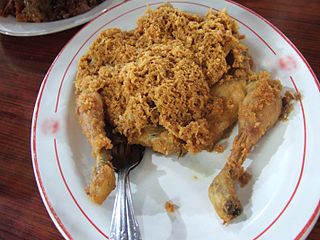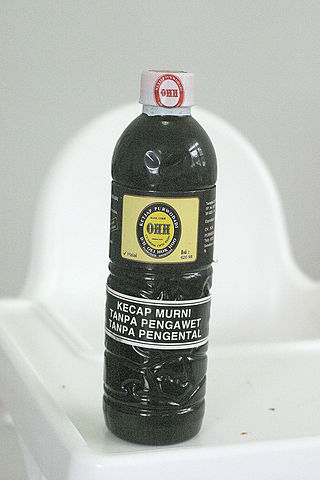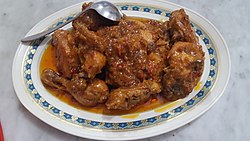
Satay, or sate in Indonesian spelling, is a Southeast Asian dish of seasoned, skewered and grilled meat, served with a sauce. The earliest preparations of satay is believed to have originated in Java island, but has spread to almost anywhere in Indonesia, where it has become a national dish. Indonesian satay is often served with peanut sauce – a sauce made from peanut butter, and is often accompanied with lontong, a type of rice cake, though the diversity of the country has produced a wide variety of satay recipes. It is also popular in many other Southeast Asian countries including Brunei, Malaysia, Philippines, Singapore and Thailand. It is also recognized and popular in Suriname and the Netherlands. In Sri Lanka, it has become a staple of the local diet as a result of the influences from the local Malay community.

Indonesian cuisine is a collection of various regional culinary traditions that formed the archipelagic nation of Indonesia. There are a wide variety of recipes and cuisines in part because Indonesia is composed of approximately 6,000 populated islands of the total 17,508 in the world's largest archipelago, with more than 1,300 ethnic groups.

Chinese Indonesian cuisine is characterized by the mixture of Chinese with local Indonesian style. Chinese Indonesians, mostly descendant of Han ethnic Hokkien and Hakka speakers, brought their legacy of Chinese cuisine, and modified some of the dishes with the addition of Indonesian ingredients, such as kecap manis, palm sugar, peanut sauce, chili, santan and local spices to form a hybrid Chinese-Indonesian cuisine. Some of the dishes and cakes share the same style as in Malaysia and Singapore, known as Nyonya cuisine by the Peranakan.

Nasi goreng is a Southeast Asian fried rice dish from Malay Archipelago. Nasi goreng is one of Indonesia's national dishes, and also a common dish in countries such as Malaysia, Singapore and Brunei. Nasi goreng has gained popularity in Sri Lanka through migrations from the Malay Archipelago, in countries like Suriname via Indonesian immigrant communities, and in the Netherlands through its colonial ties with Indonesia. Nasi goreng is distinguished from other Asian fried rice preparations by its distinct smoky aroma, and caramelised yet savoury undertones of flavour. There is no single defined recipe for nasi goreng, and its composition and preparation varies greatly from household to household.

Peanut sauce, satay sauce, bumbu kacang, sambal kacang, or pecel is an Indonesian sauce made from ground roasted or fried peanuts, widely used in Indonesian cuisine and many other dishes throughout the world.

Javanese cuisine is the cuisine of Javanese people, a major ethnic group in Indonesia, more precisely the province of Central Java, Yogyakarta and East Java.

Padang food or Minangkabau food is the cuisine of the Minangkabau people of West Sumatra, Indonesia. It is among the most popular cuisines in Maritime Southeast Asia. It is known across Indonesia as Masakan Padang after Padang, the capital city of Western Sumatra province. It is served in restaurants mostly owned by perantauan (migrating) Minangkabau people in Indonesian cities. Padang food is ubiquitous in Indonesian cities and is popular in neighboring Malaysia and Singapore.

Ayam penyet is Indonesian — more precisely East Javanese cuisine — fried chicken dish consisting of fried chicken that is squeezed with the pestle against the mortar to make it softer, and is served with sambal, slices of cucumbers, fried tofu, and tempeh. In Indonesia, penyet dishes such as fried chicken and ribs are commonly associated with Surabaya, the capital city of East Java. The most popular ayam penyet variant is ayam penyet Suroboyo.

Bumbu is the Indonesian word for a blend of spices and for pastes made from these blends, and it commonly appears in the names of spice mixtures, sauces and seasoning pastes. The official Indonesian language dictionary describes bumbu as "various types of herbs and plants that have a pleasant aroma and flavour — such as ginger, turmeric, galangal, nutmeg and pepper — used to enhance the flavour of the food."

Rica-rica is a type of Southeast Asian hot and spicy bumbu found in Minahasan cuisine and Gorontalo cuisine of Minahasa Peninsula, North Sulawesi, Indonesia.

Ayam goreng is an Indonesian and Malaysian dish consisting of chicken deep fried in oil. Ayam goreng literally means "fried chicken" in Malay, Indonesian and also in many Indonesian regional languages.

Ayam bakar is an Indonesian and Malay dish, consisting of charcoal-grilled chicken. Ayam bakar literally means "grilled chicken" in Indonesian and Malay.

Ikan bakar is an Indonesian and Malay dish, prepared with charcoal-grilled fish or other forms of seafood. Ikan bakar literally means "grilled fish" in Indonesian and Malay. Ikan bakar differs from other grilled fish dishes in that it often contains flavorings like bumbu, kecap manis, sambal, and is covered in a banana leaf and cooked on a charcoal fire.

Betutu is a Balinese dish of steamed or roasted chicken or duck in rich bumbu betutu. This highly seasoned and spiced dish is a popular dish in Bali and Lombok, Indonesia. An even spicier version is available using extra-spicy sauce made from uncooked (raw) onion slices mixed with red chili peppers and coconut oil.

Sweet soy sauce is a sweetened aromatic soy sauce, originating in Indonesia, which has a darker color, a viscous syrupy consistency and a molasses-like flavor due to the generous addition of palm sugar or jaggery. Kecap manis is widely used with satay. It is similar to, though finer in flavor than, Chinese Tianmian sauce (tianmianjiang). It is by far the most popular type of soy sauce employed in Indonesian cuisine, and accounts for an estimated 90 percent of the nation's total soy sauce production.

Ayam kecap or ayam masak kicap is an Indonesian Javanese chicken dish poached or simmered in sweet soy sauce commonly found in Indonesia, Malaysia and Singapore.

Nasi tutug oncom or sometimes simply called tutug oncom, is an Indonesian style rice dish, made of rice mixed with oncom fermented beans, originally from Tasikmalaya, West Java. It is usually wrapped in banana leaves and served with various side dishes.


















